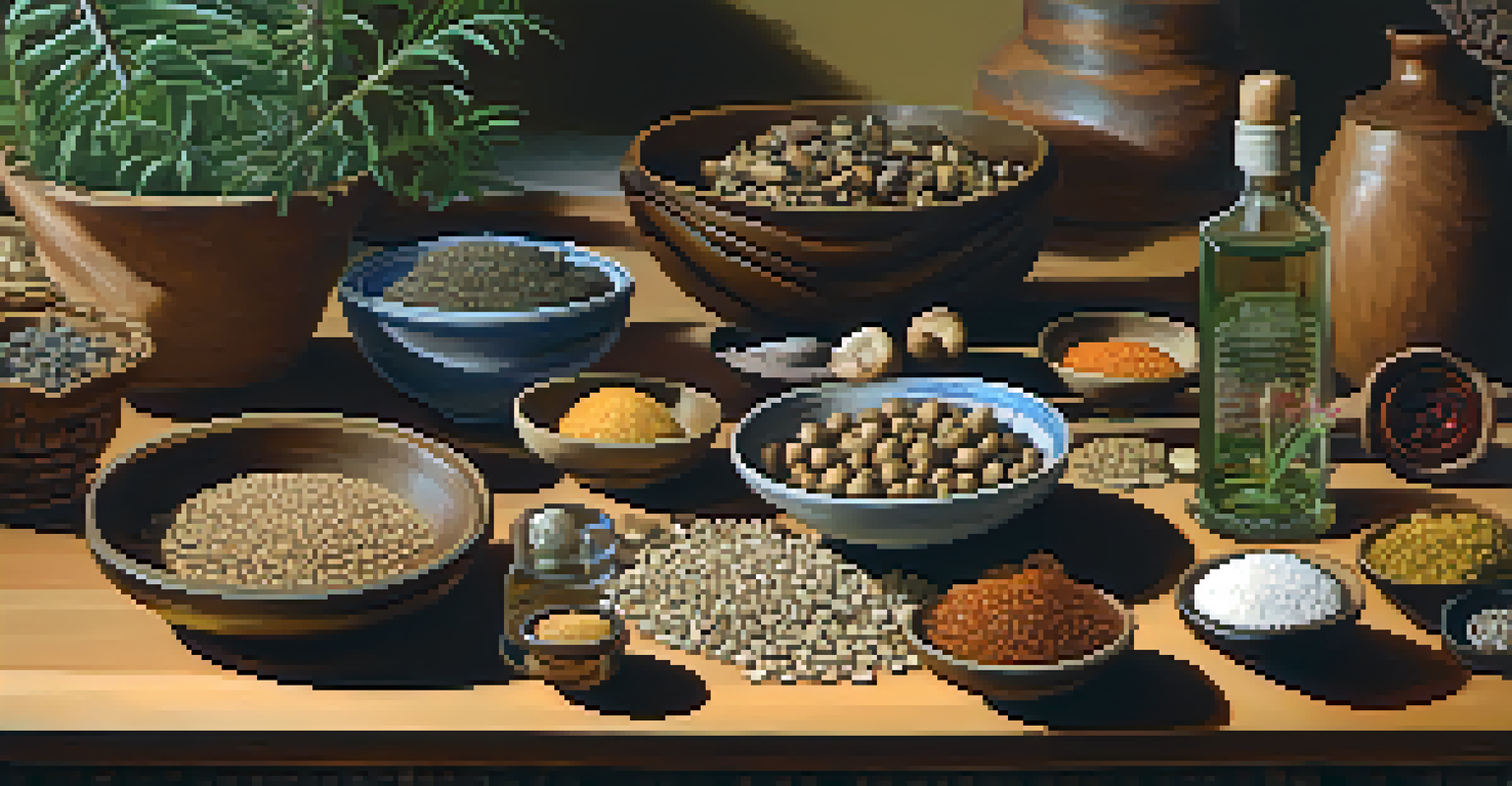Cultural Perspectives on Visions Induced by Entheogens

Understanding Entheogens and Their Cultural Significance
Entheogens are substances that induce altered states of consciousness, often used in spiritual or religious contexts. Cultures around the world have utilized these substances for centuries, viewing them as gateways to deeper understanding and connection with the divine. By exploring how various societies interpret these experiences, we can gain insight into the broader human experience and the search for meaning.
The experience of entheogens is not just an escape from reality, but a deep engagement with it—a journey into the mysteries of consciousness and existence.
For instance, in many Indigenous cultures, entheogens like peyote or ayahuasca are integral to religious rituals. These substances are not merely recreational; they are seen as sacred tools that facilitate communion with spiritual realms. As such, their use is steeped in tradition, often accompanied by specific guidelines and cultural practices that ensure respectful engagement.
This cultural significance reflects a broader human tendency to seek answers to existential questions. By understanding the role of entheogens in these contexts, we can appreciate the profound impact they have on individual and collective spirituality, shaping beliefs, practices, and worldviews across generations.
Historical Context of Entheogen Use in Different Cultures
The use of entheogens is not a modern phenomenon; it has deep historical roots. For example, the ancient Greeks used the ergot fungus in their Eleusinian Mysteries, believing it provided insights into life and death. Similarly, the Aztecs revered the mushroom teonanácatl, which they associated with divine communication, illustrating that this practice spans continents and epochs.

Historical records show that many civilizations incorporated these substances into their social and religious frameworks. The rituals surrounding their use often involved elaborate ceremonies that reinforced community bonds while offering individuals a glimpse into the transcendent. This historical perspective enriches our understanding of how deeply ingrained these practices are in human culture.
Cultural Importance of Entheogens
Entheogens have been used for centuries in various cultures as sacred tools for spiritual exploration and community bonding.
Moreover, recognizing the historical context allows us to see modern entheogen use as part of a long tradition rather than a fleeting trend. This continuity highlights the persistent human desire to engage with altered states of consciousness, emphasizing the ongoing relevance of these practices in contemporary society.
Contemporary Cultural Perspectives on Entheogens
In today's world, perspectives on entheogens are as varied as the cultures that use them. While some view them as tools for personal growth and healing, others see them through a lens of skepticism or concern, often influenced by legal and social stigmas. This dichotomy reflects broader societal attitudes toward drugs and spirituality, making the conversation around entheogens particularly nuanced.
Psychedelics can help us understand our place in the world, and reveal the interconnectedness of all things.
Many contemporary movements, like the psychedelic renaissance, advocate for the therapeutic potential of these substances, emphasizing their ability to foster healing and self-discovery. For instance, organizations are exploring how psychedelics can aid in treating mental health issues, offering a modern interpretation of ancient practices. This shift acknowledges the importance of cultural context while advocating for responsible use.
However, it's crucial to approach this topic with sensitivity, recognizing the cultural heritage behind these substances. A respectful dialogue that honors traditional practices while navigating modern interpretations can bridge the gap between skepticism and acceptance, promoting a more inclusive understanding of entheogens.
Spiritual Insights Gained from Entheogen Experiences
Individuals who partake in entheogen experiences often report profound spiritual insights and personal revelations. These moments can lead to a deeper understanding of oneself and one's place in the universe. Many describe feelings of interconnectedness with nature, humanity, and the cosmos, suggesting that these experiences have the potential to transform one’s worldview.
For instance, people may encounter archetypal symbols or profound truths during their journeys, which can serve as catalysts for personal growth. Such insights can lead to lasting changes in behavior, values, and relationships, reflecting the transformative power of these experiences. This sense of awakening resonates with various spiritual traditions that emphasize the importance of inner exploration.
Historical Roots of Entheogen Use
The use of entheogens spans ancient civilizations, highlighting a long-standing human desire to engage with altered states of consciousness.
Moreover, these insights often encourage individuals to share their experiences with others, fostering communities centered around mutual understanding and support. As people gather to discuss their journeys, they create a collective narrative that validates and enriches the spiritual significance of entheogens across cultures.
Comparing Indigenous and Western Views on Entheogens
Indigenous cultures often approach entheogens with a sense of reverence, viewing them as sacred tools for spiritual exploration. In contrast, Western perspectives have historically oscillated between fascination and fear, influenced by legal restrictions and societal norms. This divergence in views shapes how each culture engages with these substances, impacting both personal and communal practices.
For Indigenous peoples, entheogens are embedded within a rich tapestry of tradition and community. They are used in ceremonial contexts and often accompanied by rituals that enhance the experience. In contrast, the Western approach is frequently more individualistic, sometimes reducing the experience to a personal journey devoid of communal context, which can lead to misunderstandings of the substance’s true potential.
By examining these differing views, we can appreciate the complexities of entheogen use. Acknowledging the value of Indigenous knowledge while integrating contemporary insights can foster a more holistic understanding of entheogens, encouraging dialogue that respects both traditions and modern interpretations.
The Role of Set and Setting in Entheogen Experiences
The concepts of 'set' and 'setting' play a crucial role in shaping entheogen experiences. 'Set' refers to the individual's mindset, including their emotions, expectations, and intentions. Meanwhile, 'setting' encompasses the physical and social environment in which the experience occurs. Together, these factors can significantly influence the nature of the journey and the insights gained.
For example, a supportive, calm environment can enhance feelings of safety and openness, allowing individuals to dive deeper into their experiences. Conversely, a chaotic or uncomfortable setting may lead to anxiety or confusion, detracting from the potential benefits. This highlights the importance of preparation and intention when engaging with entheogens.
Modern Views on Entheogens
Contemporary perspectives on entheogens vary widely, balancing therapeutic potential with cultural respect and societal skepticism.
Understanding the significance of set and setting encourages respectful practices that honor the substance's potential. By fostering environments conducive to meaningful experiences, individuals can maximize the spiritual and therapeutic benefits of entheogens while minimizing risks.
Future Directions in Cultural Perspectives on Entheogens
As society continues to evolve, so too will the cultural perspectives on entheogens. Increasing interest in their therapeutic applications is prompting a reevaluation of long-held beliefs and legal frameworks. This shift could lead to a greater acceptance of entheogens, allowing for more open discussions about their benefits and risks.
Furthermore, interdisciplinary research combining anthropology, psychology, and pharmacology is paving the way for a more nuanced understanding of these substances. By exploring the intersection of culture, psychology, and biology, we can uncover new insights that honor traditional practices while addressing contemporary concerns.

Ultimately, the future of entheogen use will likely involve a collaborative effort to reconcile traditional wisdom with modern scientific understanding. This integration can foster a more respectful and informed dialogue surrounding entheogens, enriching both individual experiences and cultural narratives.